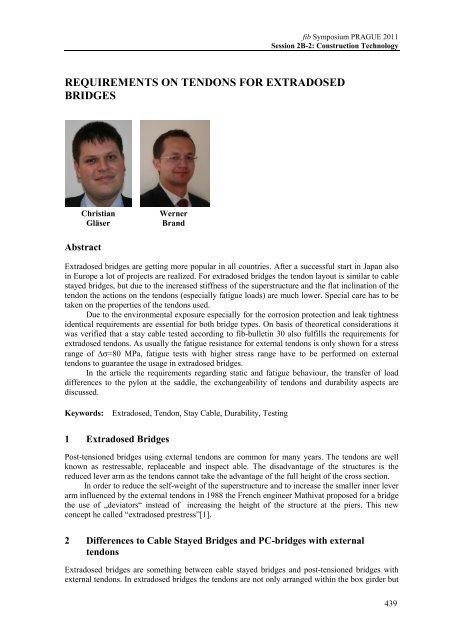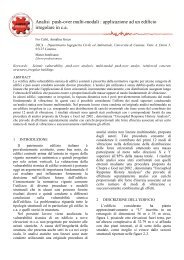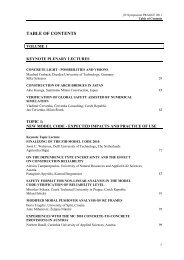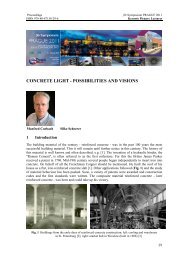REQUIREMENTS ON TENDONS FOR EXTRADOSED BRIDGES
REQUIREMENTS ON TENDONS FOR EXTRADOSED BRIDGES
REQUIREMENTS ON TENDONS FOR EXTRADOSED BRIDGES
Create successful ePaper yourself
Turn your PDF publications into a flip-book with our unique Google optimized e-Paper software.
fib Symposium PRAGUE 2011<br />
Session 2B-2: Construction Technology<br />
<strong>REQUIREMENTS</strong> <strong>ON</strong> TEND<strong>ON</strong>S <strong>FOR</strong> <strong>EXTRADOSED</strong><br />
<strong>BRIDGES</strong><br />
Christian<br />
Gläser<br />
Abstract<br />
Werner<br />
Brand<br />
Extradosed bridges are getting more popular in all countries. After a successful start in Japan also<br />
in Europe a lot of projects are realized. For extradosed bridges the tendon layout is similar to cable<br />
stayed bridges, but due to the increased stiffness of the superstructure and the flat inclination of the<br />
tendon the actions on the tendons (especially fatigue loads) are much lower. Special care has to be<br />
taken on the properties of the tendons used.<br />
Due to the environmental exposure especially for the corrosion protection and leak tightness<br />
identical requirements are essential for both bridge types. On basis of theoretical considerations it<br />
was verified that a stay cable tested according to fib-bulletin 30 also fulfills the requirements for<br />
extradosed tendons. As usually the fatigue resistance for external tendons is only shown for a stress<br />
range of ∆σ=80 MPa, fatigue tests with higher stress range have to be performed on external<br />
tendons to guarantee the usage in extradosed bridges.<br />
In the article the requirements regarding static and fatigue behaviour, the transfer of load<br />
differences to the pylon at the saddle, the exchangeability of tendons and durability aspects are<br />
discussed.<br />
Keywords: Extradosed, Tendon, Stay Cable, Durability, Testing<br />
1 Extradosed Bridges<br />
Post-tensioned bridges using external tendons are common for many years. The tendons are well<br />
known as restressable, replaceable and inspect able. The disadvantage of the structures is the<br />
reduced lever arm as the tendons cannot take the advantage of the full height of the cross section.<br />
In order to reduce the self-weight of the superstructure and to increase the smaller inner lever<br />
arm influenced by the external tendons in 1988 the French engineer Mathivat proposed for a bridge<br />
the use of „deviators“ instead of increasing the height of the structure at the piers. This new<br />
concept he called “extradosed prestress”[1].<br />
2 Differences to Cable Stayed Bridges and PC-bridges with external<br />
tendons<br />
Extradosed bridges are something between cable stayed bridges and post-tensioned bridges with<br />
external tendons. In extradosed bridges the tendons are not only arranged within the box girder but<br />
439
fib Symposium PRAGUE 2011<br />
Session 2B-2: Construction Technology<br />
also outside of the box girder. The superstructure is much stiffer compared to usual cable-stayed<br />
bridges and the pylon height is smaller related to the maximum span. Due to the gently inclined<br />
tendons the main component of the tendon forces is introduced as longitudinal load into the girder<br />
that is acting similar to a post-tensioned girder.<br />
Compared to external tendons additional requirements are necessary for the corrosion<br />
protection in the free length because the tendons are permanently exposed to outdoor weathering.<br />
The requirements for the resistance against fatigue are more severe compared to external tendons,<br />
too, but lower than for stay cables.<br />
If the tendon layout requires saddles at the pylons it has to be guaranteed that the flexural<br />
stresses at the ends of the saddles are minimized. Additionally it has to be verified that the<br />
sheathing is not damaged due to friction. If the tendons shall be replaceable this must be<br />
demonstrated, too.<br />
3 Requirements on the components of the tendons<br />
Currently no international standard for the design of extradosed bridges or international guideline<br />
for testing and installation are existing. A fib task group is preparing an update of the existing<br />
bulletin 30 [2]. The actual version is only covering stay cables and cable-stayed bridges. It shall be<br />
extended for extradosed tendons and extradosed bridges. In the existing guideline the individual<br />
components as well as the requirements on the total cable are described.<br />
Due to the high exposure of the extradosed cables more restrictive requirements compared<br />
tousual external tendons have to be fulfilled.<br />
The corrosion protection of the strand itself has to be defined. As for stay cables mostly<br />
galvanized waxed and PE-coated strands are used. It has to be discussed whether usual<br />
monostrands (without zinc) can be acceptable, too.<br />
As the fatigue actions are higher compared to post-tensioned concrete bridges a higher<br />
fatigue resistance is necessary. Therefore, it is recommended to use the high fatigue level that is<br />
also required for stay cable strands or wire. This can be verified in fatigue tests without anchorages<br />
using an upper stress level of 0.65 Fpk, 2 ·10 6 load cycles and a stress range of 250 N/mm 2 for<br />
strands resp. 300 N/mm 2 for wires. If fillers or coatings are used similar requirements as existing<br />
for stay cable strand have to be defined.<br />
For the outer sheathing of the cable mostly colored HDPE pipes are used. The stability<br />
against UV radiation and color stability can be demonstrated in accelerated artificial weathering<br />
tests.<br />
4 Requirements on the tendons<br />
In Europe external tendons – like bonded tendons - are usually stressed to 72% - 80 % of the<br />
characteristic tensile strength. During the approval procedure tests with a stress range of 80 N/mm 2<br />
at 2 · 10 6 load cycles are performed to define the minimum required level of fatigue resistance.<br />
Stay cables using prestressing steel are usually loaded to 45% of the characteristic tensile<br />
strength of the single strand. To verify the high fatigue resistance the cables are tested with a stress<br />
range of 200 N/mm 2 for 2 · 10 6 load cycles. Test specimens consist of two anchorages with the<br />
original components and minimum free length of 0.5 m according to fib-bulletin 30. As in<br />
extradosed bridges due to the stiffer superstructure lower stress ranges will apply a higher stressing<br />
level seems to be acceptable (60% of the characteristic tensile strength of the strands). Besides all<br />
discussion a S-shape tendon layout in the test as shown in the actual version of fib-bulletin 30<br />
(α=10 mrad) is considering the influence of fatigue bending sufficiently for extradosed tendons<br />
because more severe bending influences will not occur due to the stiff superstructure.<br />
During the initial type testing of a new stay cable or extradosed tendon three axial fatigue and<br />
tensile tests (if different sizes are used, a small, medium and large one) should be tested. On basis<br />
440
fib Symposium PRAGUE 2011<br />
Session 2B-2: Construction Technology<br />
of studies of Nürnberger [3], [4] Smith diagrams for prestressing steel were created. Thus, it could<br />
be shown, that all Stay Cable Tests according to fib-bulletin 30 can be accepted (fatigue test with<br />
stress range 200 MPa at upper load level 45% GUTS) to verify the requirements on extradosed<br />
tendons.<br />
Existing tests with test layout according to fib-bulletin 30 with different stress ranges can be<br />
used if the upper load (not the stress range) exceeds the tested one (see Tab. 1 resp. Fig 1).<br />
Tab. 1 Characteristics on the sheathing of<br />
the tendons<br />
Upper<br />
load level<br />
45% F pk<br />
50% F pk<br />
Stress range for<br />
strand tendons<br />
200 N/mm 2<br />
190 N/mm 2<br />
Stress range for<br />
wire tendons<br />
200 N/mm 2<br />
190 N/mm 2<br />
55% F pk 180 N/mm 2 180 N/mm 2<br />
60% F pk 170 N/mm 2 170 N/mm 2<br />
65% F pk 160 N/mm 2 160 N/mm 2<br />
70% F pk 150 N/mm 2 150 N/mm 2 Fig. 1 Relation between stress range and upper load<br />
If new types of tendons are developed for extradosed bridges maybe reduced requirements<br />
regarding the resistance against fatigue are sufficient. If it corresponds to the application maybe a<br />
fatigue test with upper stress level of 0.65 Fpk, 2 ·10 6 load cycles and stress range 160 N/mm 2 is<br />
possible (see Tab. 1).<br />
For all tendon developments suitability testing and one leak tightness test according to fibbulletin<br />
30 are necessary. If saddles are used one saddle test on a medium tendon size should be<br />
performed. Project specific at least five static tensile and five fatigue tests on anchored single<br />
strands with upper loads as foreseen for the project and stress ranges according to table 2 seems to<br />
be sufficient.<br />
5 Saddles<br />
If the single strands are deviated at the pylon using special saddles also extradosed tendons have to<br />
be tested according to fib-bulletin 30 [2], section 6.2.2 (see Fig. 2). If different tendon sizes shall be<br />
used a medium size can be tested. The same stress ranges as described for axial testing (see table 2)<br />
seems to be realistic. During the static tensile test on deviated tendons it shall be measured if load<br />
differences in the tendon on both sides of saddles can be transferred to the pylon at the saddle.<br />
After the test damages such as wear or cuts to the duct and sheathing of the tensile elements<br />
shall be measured and recorded. The minimum remaining thickness of duct and sheathing can be<br />
measured. Relative movements between tendon components, i.e. tensile element and duct, and<br />
tensile element and sheathing shall be observed. If required strand replaceability can be<br />
demonstrated after the test.<br />
441
fib Symposium PRAGUE 2011<br />
Session 2B-2: Construction Technology<br />
442<br />
Fig. 2 Layout for saddle testing<br />
If saddle solutions in steel are used where the strands are anchored on both sides of the pylons no<br />
testing is required.<br />
6 Conclusions<br />
All stay cables which had been successfully tested according to fib-bulletin 30 can be used for<br />
extradosed bridges, too. Only project specific tests on anchored single strand seems to be sufficient.<br />
If external tendons shall be developed for the use in extradosed bridges special care shall be taken<br />
to all durability aspects.<br />
References<br />
[1] Mathivat, J.: Recent developments in prestressed concrete bridges. In: FIP (Federation<br />
internationale de la precontrainte) notes. Nr. 2, 1988, S. 15–21.<br />
[2] Fédération internationale du béton (fib-bulletin 30): Recommendations for the Acceptance of<br />
Stay Cable Systems using Prestressing Steels (2005).<br />
[3] Nuernberger, U.; Patzak, M.: Metallische Verankerungen für dynamisch beanspruchte Zugglieder<br />
(metallic anchorages for tendons with dynamic actions). SFB 64, University<br />
Stuttgart, 1978.<br />
[4] Nuernberger, U.: Dauerschwingverhalten von Spannstählen (Fatigue behaviour of<br />
prestressing steels). In: Bauingenieur 56, page 311-319, Springer-Verlag, 1981.<br />
Dr.-Ing. Christian Gläser<br />
� DYWIDAG-Systems International GmbH<br />
Regional Headquarter Europe<br />
Siemensstraße 8<br />
85716 Unterschleißheim, Germany<br />
� +49 89 309050-149<br />
� +49 89 309050-120<br />
☺ christian.glaeser@dywidag-systems.com<br />
URL http://www.dywidag-systems.com<br />
Dipl.-Ing. Werner Brand<br />
� DYWIDAG-Systems International GmbH<br />
Technical Services Stay Cables<br />
Siemensstraße 8<br />
85716 Unterschleißheim, Germany<br />
� +49 89 309050-177<br />
� +49 89 309050-170<br />
☺ werner.brand@dywidag-systems.com<br />
URL http://www.dywidag-systems.com







